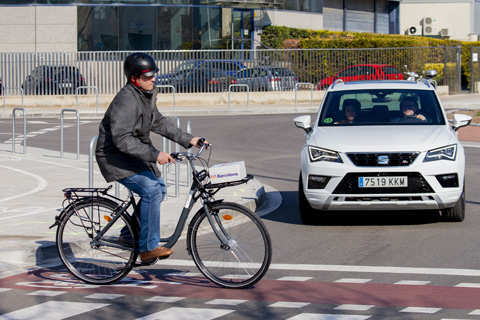At MWC 2019 and within the framework of the 5G Barcelona agreement with Ficosa, ETRA, i2Cat and Mobile World Capital Barcelona
- The road infrastructure and vulnerable road users will “speak” with the car as the mobile network issues car-alerts to avert any danger or complex situations.
- The connected car communicates with all the surrounding elements using Ficosa’s C-V2X technology, which offers two types of communications: traditional via mobile network; and direct, point-to-point connectivity.
- The deployment of 5G capabilities, specifically Ericsson’s Edge Computing solution, makes these use cases possible by providing computing capacity at the edge of the network and minimum latencies.
- Leveraging on the high bandwidth provided by 5G, this is also the world’s first case of 5G in-car entertainment with 4K content downloads provided by Qualcomm Technologies next generation mobile platform.
Madrid, 18 February 2019.- The streets of L’Hospitalet de Llobregat will be the scenario of the connected car and 5G assisted driving use cases in a real environment thanks to the joint work of Telefónica, SEAT, Mobile World Capital Barcelona, Ficosa, ETRA e i2CAT, and with the collaboration of CTTC and UPC. Ericsson and Qualcomm Technologies, Inc. -a subsidiary of Qualcomm Incorporated-, also participated, by equipping both vehicles and their surrounding elements with technology that enables them to exchange information with the main objective of increasing road safety. The project is framed within the 5G Barcelona initiative, aimed at consolidating the city of Barcelona as the reference 5G hub in Europe.
The two technologies bringing these use cases to life are C-V2X (Cellular Vehicle to Everything) and .C-V2X technology offers assisted driving by allowing the vehicle to communicate with all the elements around it (cars, traffic lights, traffic signals, pedestrians, cyclists, motorcycles…). In addition, for the cars to be able to “talk” to the city, latency needs to be minimal and, therefore, it is necessary to deploy 5G capabilities into the current network, specifically the Edge Computing server, a large distributed brain, hosting content and applications very close to where the user is consuming them.
SEAT contributed with two vehicles, Ateca and Arona models, equipped with the latest technology in connectivity and instrument panels that issue warnings to the driver. Telefónica provides the end-to-end connectivity and, as a novelty, is opening-up its network so third parties can deploy applications at the edge of the network, such as traffic management for this use case. Ficosa has developed and produced the in-car C-V2X communications platform that allows the transmission of information from the car to any entity that might impact the vehicle, and vice versa; i2CAT, in charge of the development of the ultra-precise location solution for bicycles; ETRA, supplier of the road infrastructure that provided connectivity with the traffic light system, and Mobile World Capital Barcelona, representing 5G Barcelona, the global supervisor of the project, also offering management support.Ericsson has provided 5G technology and Qualcomm Technologies the 5G connectivity platform both for the network communication and for the direct communication.
Specifically, all three assisted driving use cases that will be presented in Barcelona at the surrounding area of the Fira, where Mobile World Congres is taking place are;
- Detection of a pedestrian at a zebra crossing: the traffic lights will detect the presence of pedestrians at zebra crossings through a thermal camera and, via Edge Computing, will notify the cars, which will display a notice on the control panel, if necessary.
- Detection of cyclists when turning right: a connected bicycle equipped with a precise geolocation solution via Edge Computing communicates with cars the around it and report their location. In the event of a possible collision, cars will display a warning in the control panel. Bicycles can be located thanks to the ultra-wideband beacons placed along the road.
- Detection of a non-moving car on the road with low visibility: the non-moving car in an area of the road with low visibility activates emergency lights and automatically notifies other approaching vehicles with a message in the control panel. This communication is done through a direct communication interface.
With these use cases, Telefónica helps cars, infrastructure of the roads, bicycles, in summary, all urban elements become new sensors in the city. In addition, implementing Ficosa’s C-V2X technology in cars provides the driver with a “sixth sense” to allow them to make decisions in advance and room to manoeuvre, all aimed at making our cities safer and more efficient.
In addition to these safety use cases, this is also the world’s first use case of 5G in-car entertainment including the download of 4K contents through 5G. In this case, the car is equipped with the new Qualcomm 5G chipset, which, together with the video storage at the Edge, allows the streaming of 4K contents.
For further press information:
Telefónica
External Communication Department
prensatelefonica@telefonica.com
+34 91482 38 00
|
Daniel Martinez Corporate Communications M/ +34 648 280 851 |
SEAT Comunicación
Cristina Vall-Llosada
Head of Corporate Communication
M/ +34 646 295 296
Mobile World Capital Barcelona
Estel Estopiñán
PR & Public Affairs Manager
+34 656 258 394
eestopinan@mobileworldcapital.com
Ficosa
Communications Area:
Tel: +34- 660 20 10 20
Mònica Acero: macero@arenalia.com +34 615 07 59 81
Lluís Gubern: lgubern@arenalia.com +34 699 56 39 54
i2CAT Foundation
Susana Otero
Corporate Development Manager
M/ +34 605 696 426
